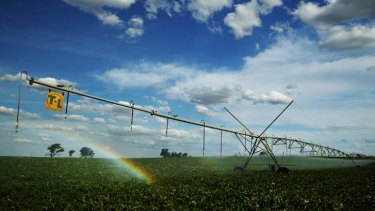‘Beyond chemicals’: Farming for nature can feed a growing world
Farming practices and expansion are among the biggest threats to nature, but one of the biggest threats to agriculture and its ability to feeding the world is nature's declining health.
It's a difficult problem that must be tackled on a world scale, with the global population forecast to grow from 7.7 billion to hit 11 billion by 2100.
Australian farms will need to become more innovative to reverse damaging declines in natural ecosystems and feed the world’s growing population. Credit:Jessica Hromas
But a study in the journal Nature, released on Thursday, found more than two thirds of future biodiversity losses from habitat conversion could be avoided with policies to establish markets for sustainably produced food and encourage healthier, sustainable diets, as well as encourage industry innovation.
"We found that apart from increased conservation efforts, the the biggest effect on biodiversity will come from how you managed the food system – especially land use, farming, food consumption and waste reduction," said CSIRO chief research scientist Mario Herrero, one of the report authors.
Australia is helping lead the way in a key area – farm innovation.
For example, the cotton industry encourages biodiversity by breeding beneficial insects and dropping them via using drones on crops to keep down the numbers of hungry caterpillars.
Australia Farm Institute executive director Richard Heath is "bullish" about the prospects for farming innovations but warned progress depends on consumer demand.
"This creates a new solution beyond what's in a chemical drum, and recognises that biology which underpins farming is key to sustainable agriculture," Mr Heath said.
Other existing innovations that can improve farming systems include GPS-guided robots to target micro-doses of crop boosting fertiliser at crops, making drip irrigation systems cheaper and more available to improve water efficiency, using feed additives to reduce greenhouse gas emissions from livestock and nutritional supplements to boost cattle growth rates, among others.
But, Mr Heath said, a "brutal realisation for some people was transformation would only happen as quickly as the community is prepared to pay for it".
Habitat loss from clearing for agriculture is a major cause of biodiversity loss. Last year a United Nations study by 150 experts found one million species around the world including 40 per cent of all amphibians, nearly 30 per cent of mammals and 10 per cent of insects are under threat from extinction.
Another author of the Nature study, CSIRO chief research scientist Simon Ferrier, said "diversity is seen as critical to have ecosystems survive into the future and continue to provide ecosystem services".
Around 75 per cent of food crops need wild insects for pollination, the health of water resources like rivers is sustained by diverse plants and animals, and native habitats like forests prevent predators, insects and weeds becoming pests by encroaching on farmland.
Dr Herrero said policies to drive innovation are most needed in low and middle income countries which have the greatest opportunities to improve production systems and food markets but where people have the least capacity to pay more for food.
Most Viewed in Politics
Source: Read Full Article
